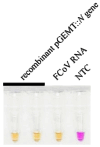Colorimetric Reverse Transcription Loop-Mediated Isothermal Amplification with Xylenol Orange Targeting Nucleocapsid Gene for Detection of Feline Coronavirus Infection
- PMID: 40143345
- PMCID: PMC11946810
- DOI: 10.3390/v17030418
Colorimetric Reverse Transcription Loop-Mediated Isothermal Amplification with Xylenol Orange Targeting Nucleocapsid Gene for Detection of Feline Coronavirus Infection
Abstract
Feline infectious peritonitis (FIP), a devastating disease with near-complete mortality, is caused by the feline coronavirus (FCoV) and affects domestic cats worldwide. Herein, we report the development of a reverse transcription loop-mediated isothermal amplification (RT-LAMP) assay incorporating xylenol orange (XO) as a visual indicator for FCoV detection. The assay employed six oligonucleotide primers targeting regions of the nucleocapsid (N) gene. Under optimized conditions (65 °C, 60 min), amplification products were detected through pH-dependent colour changes in the XO dye. The RT-LAMP-XO assay exhibited high specificity for FCoV, with no cross-reactivity against other common feline viral pathogens. While the detection limit (1.7 × 101 copies/µL) was an order of magnitude higher than that of qPCR, the method offered advantages in simplicity and speed compared to existing diagnostic approaches. Although less sensitive than qPCR, the RT-LAMP-XO assay may serve as a rapid screening tool when used in combination with additional primer sets. These findings demonstrate the potential utility of XO-based RT-LAMP as a simple, visual detection method for FCoV infection.
Keywords: FIP; RT-LAMP; Xylenol orange; feline corona virus; qPCR.
Conflict of interest statement
The authors declare no conflicts of interest.
Figures







Similar articles
-
Detection of Feline Coronavirus Membrane Gene Based on Conventional Revere Transcription-Polymerase Chain Reaction, Nested Reverse Transcription-Polymerase Chain Reaction, and Reverse Transcription-Quantitative Polymerase Chain Reaction: A Comparative Study.Int J Mol Sci. 2025 Jul 17;26(14):6861. doi: 10.3390/ijms26146861. Int J Mol Sci. 2025. PMID: 40725108 Free PMC article.
-
A colloidal gold immunochromatographic test strip based on mAbs anti-N protein to detect feline coronavirus.Microbiol Spectr. 2025 Jul;13(7):e0183024. doi: 10.1128/spectrum.01830-24. Epub 2025 Jun 2. Microbiol Spectr. 2025. PMID: 40454842 Free PMC article.
-
Pan-serotype reverse transcription loop-mediated isothermal amplification (RT-LAMP) assay targeting 2B-NSP coding region for colorimetric detection of foot-and-mouth disease virus in clinical samples.Virus Genes. 2025 Aug;61(4):490-497. doi: 10.1007/s11262-025-02158-y. Epub 2025 Apr 26. Virus Genes. 2025. PMID: 40285984
-
Antibody tests for identification of current and past infection with SARS-CoV-2.Cochrane Database Syst Rev. 2022 Nov 17;11(11):CD013652. doi: 10.1002/14651858.CD013652.pub2. Cochrane Database Syst Rev. 2022. PMID: 36394900 Free PMC article.
-
Diagnostic test accuracy and cost-effectiveness of tests for codeletion of chromosomal arms 1p and 19q in people with glioma.Cochrane Database Syst Rev. 2022 Mar 2;3(3):CD013387. doi: 10.1002/14651858.CD013387.pub2. Cochrane Database Syst Rev. 2022. PMID: 35233774 Free PMC article.
Cited by
-
Detection of Feline Coronavirus Membrane Gene Based on Conventional Revere Transcription-Polymerase Chain Reaction, Nested Reverse Transcription-Polymerase Chain Reaction, and Reverse Transcription-Quantitative Polymerase Chain Reaction: A Comparative Study.Int J Mol Sci. 2025 Jul 17;26(14):6861. doi: 10.3390/ijms26146861. Int J Mol Sci. 2025. PMID: 40725108 Free PMC article.
References
-
- Masters P.S., Perlman S. Coronaviridae. Fields Virol. 2013;1:825–858.
-
- Ehmann R., Kristen-Burmann C., Bank-Wolf B., König M., Herden C., Hain T., Thiel H.J., Ziebuhr J., Tekes G. Reverse Genetics for Type I Feline Coronavirus Field Isolate to Study the Molecular Pathogenesis of Feline Infectious Peritonitis. mBio. 2018;9:e01422-18. doi: 10.1128/mBio.01422-18. - DOI - PMC - PubMed
Publication types
MeSH terms
Substances
Supplementary concepts
LinkOut - more resources
Full Text Sources
Miscellaneous

